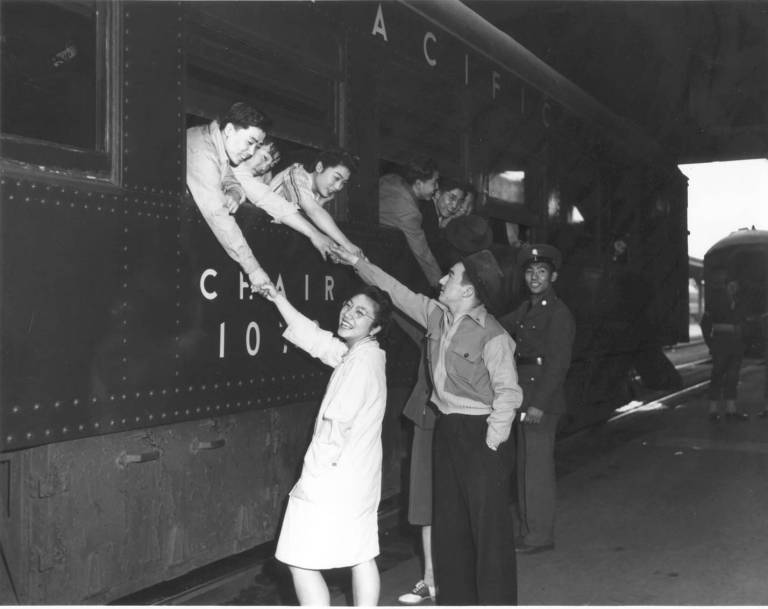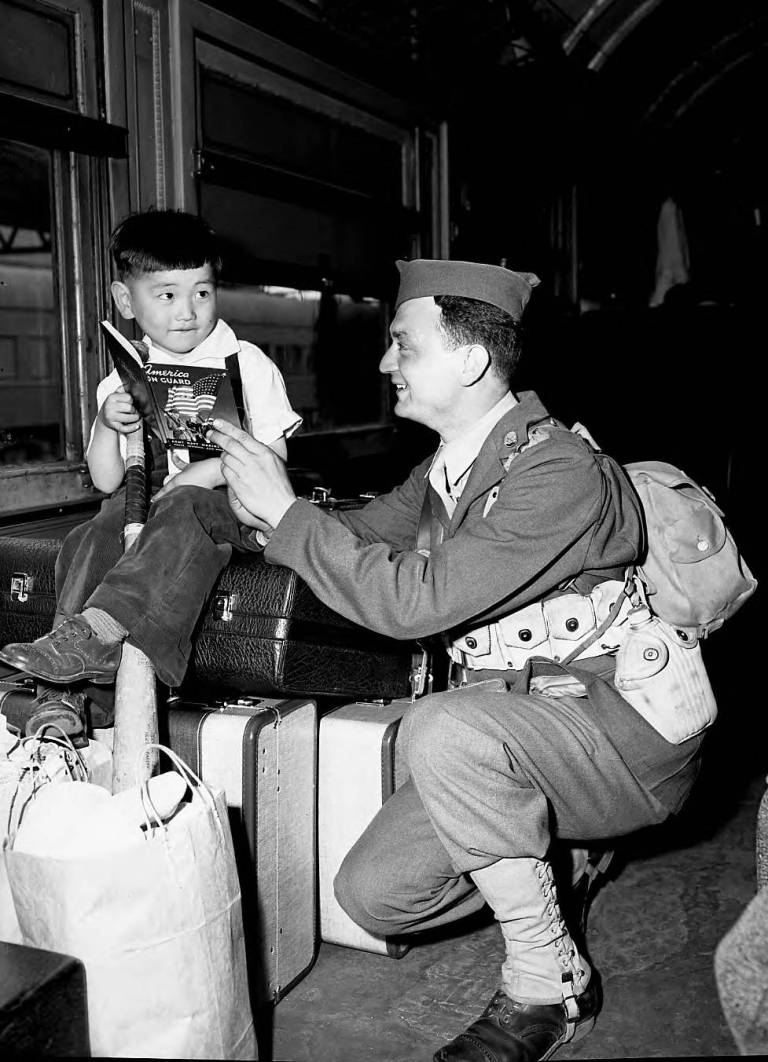The intersection between Tacoma’s history and America’s story doesn’t get much more powerful and poignant than the events captured in these photographs, taken at Union Station on May 17th and 18th 1942. Over the two days about a 1000 residents of Tacoma and the Fife valley began the internment process under the terms of Executive Order 9066. These images can certainly been seen through the lens of global politics and the suddenness of world war two on the Pacific Coast. But perhaps the most momentous thing about them are the small, calm details of how an entire neighborhood of Tacomans dealt with the loss of home and liberty in a time of uncertainty and fear.
On a Sunday afternoon, and then again the next day, virtually all of the families in Tacoma’s Nihonmachi dutifully walked or were driven to Union Station with only the possessions they could carry. Union Station was a ceremonious landmark on the edge of Japantown and for the many hoteliers, messengers and red caps that worked there it was part of their neighborhood. Nearly everyone knew the grand building well, having met or waved goodbye to traveling friends or family under it ornate copper dome. On this Spring day, they walked through the familiar rotunda, down the concourse and onto to the sidings for special southbound trains. There they surrendered their liberty to armed military police and entered into the custody of federal interment, every family member of every family, even the children.
Tacoma’s Japanese community chose to wear their best clothes for the day. They spent precious cash on new suitcases and going away gifts for their friends. These photos tell the story of the time and place.
Ξ
On February 19, 1942 President Franklin D. Roosevelt issued Executive Order 9066. This action eventually led to the removal of some 110,000 Japanese-Americans to internment camps in remote areas of Arizona, Arkansas, California, Colorado, Idaho, Utah and Wyoming. This little girl was photographed at Tacoma’s Union Station as she and her family prepared to board a train to the Pinedale, California assembly center camp. 879 Japanese-Americans from the Tacoma “restricted area” left for Pinedale beginning on May 17, 1942. (T. Times)
issued Executive Order 9066. This action eventually led to the removal of some 110,000 Japanese-Americans to internment camps in remote areas of Arizona, Arkansas, California, Colorado, Idaho, Utah and Wyoming. This little girl was photographed at Tacoma’s Union Station as she and her family prepared to board a train to the Pinedale, California assembly center camp. 879 Japanese-Americans from the Tacoma “restricted area” left for Pinedale beginning on May 17, 1942. (T. Times)
A uniformed soldier checks the  baggage of the Japanese Americans boarding a train at Union Station to be shipped to Pinedale “Assembly Center.” On May 17-18th, the Tacomans were sent by train to the internment campin Northern California where after the sweltering summer months they were again relocated to the Tule Lake relocation center near the California Oregon border. (T. Times 5/18/1942, pg. 1+)
baggage of the Japanese Americans boarding a train at Union Station to be shipped to Pinedale “Assembly Center.” On May 17-18th, the Tacomans were sent by train to the internment campin Northern California where after the sweltering summer months they were again relocated to the Tule Lake relocation center near the California Oregon border. (T. Times 5/18/1942, pg. 1+)

Tsuyoshi Horike, left, and Hanako Horike reach out the train window to Miya Fukuyama. An unidentified youth reaches for the hand of Salem Yagawa. Isamu Kawakumi & Charles Miyoshi bid farewell to Noboru Taki, in uniform. The 418 departing on the 17th would be joined with their friends in California as 441 more departed on Monday. All four of the young men in the photograph grew up in the White River Valley area near Auburn. The Taki family owned a parking garage in downtown Tacoma and the young men were helping their friend Noboru, 22, with the business. In early 1942, Noboru was drafted and, in March, inducted into the army. The same day as he departed, his father was arrested by the Department of Justice for suspected anti-American affiliations. He was later released to reunite with his incarcerated family. Norboru Taki, after serving his country at war as his family resided in a detention camp, settled in Auburn. He and his wife later moved to Seattle where they raised five children. (T. Times 5/18/1942, pg. 1; TNT 5/18/2003,)
Members of the Yoshigiro Yamada family gather around a radio on the train departing Tacoma’s Union Station for Fresno’s Pinedale Assembly Center on May 17, 1942. During the late 30’s and early 40’s, the Yamada family was separated. The six children lived with their mother Chiyeko Yamada in Seattle; their father ran the Vasa Hotel on Pacific Avenue in Tacoma. In June of 1941, Mrs. Yamada died and the children came to live with their father in Tacoma. Several months after President Franklin Roosevelt issued Executive Order 9066, the children were uprooted a second time and sent to the internment camp.The group are, left to right, twins Teddy and Kathryn (12), Robert (8) and Eddie (19.) (T. Times 5/18/1942, pg. 1, 14; TNT 5/18/2003, pg.)
gather around a radio on the train departing Tacoma’s Union Station for Fresno’s Pinedale Assembly Center on May 17, 1942. During the late 30’s and early 40’s, the Yamada family was separated. The six children lived with their mother Chiyeko Yamada in Seattle; their father ran the Vasa Hotel on Pacific Avenue in Tacoma. In June of 1941, Mrs. Yamada died and the children came to live with their father in Tacoma. Several months after President Franklin Roosevelt issued Executive Order 9066, the children were uprooted a second time and sent to the internment camp.The group are, left to right, twins Teddy and Kathryn (12), Robert (8) and Eddie (19.) (T. Times 5/18/1942, pg. 1, 14; TNT 5/18/2003, pg.)

Five year old Toshiyuki Hattori smiles at the camera over his book. At his side is military guard Pvt. Nat Schwartz. On Feb. 19th, 1942 President Franklin Delano Roosevelt issued an executive order authorizing the military to banish anyone it considered potentially dangerous from any region considered to be at risk. On March 2nd, the plan was revealed to remove anyone with Japanese ancestry from the entire West Coast. Tacoma’s turn came May 17 & 18th, 1942, when virtually all of the city’s downtown Japanese American community was shipped from Union Station to Pinedale Assembly Center near Fresno California. (T. Times 5/18/1942, pg. 1; TNT 5/18/2003, pg. B8+)
These images are from a larger collection at the Northwest Room at the Tacoma Public Library. While most political voices and the press supported or at least were silent on the President’s Executive Order, Tacoma and the Fife Valley never voiced support for relocation. Tacoma Mayor Harry Cain was the only elected leader of a large American city to steadfastly speak against the social injustice of internment for 110,000 people of Japanese decent, most of them U.S.citizens.

Thank you so much for sharing this invaluable perspective.
LikeLike
I don’t remember too much about going to camp as I believe I was about 2 years old. It probably was a difficult trip for my parents as my older brother was 5 yrs old & my younger sister was an infant! I think I got sick on the train (I got sick on anything that moved) my sister & I came down with the measles and were separated from our family, I am sure to stop an epidemic ! We were at the camp hospital I was told my Uncles sisters worked at the hospital so they would let my Mom know how we were doing!
I remember returning to Tacoma, Via the Union Station each of carrying something, I remember what I thought were tall buildings & going up the hills to Fawcett Ave & staying at the Japanese Methodist Church! Our room there was the front entry of the church! From there we went to live in the Japanese School House on Tacoma Avenue. My Mom went shopping every day and cooked on a burner on the floor! We bathed at the Fujimoto home, they employed my Father at their dry cleaners!
LikeLike
As always, Great writing and history lesson.How did the internment camp in Puyallup play a part in this?
LikeLike